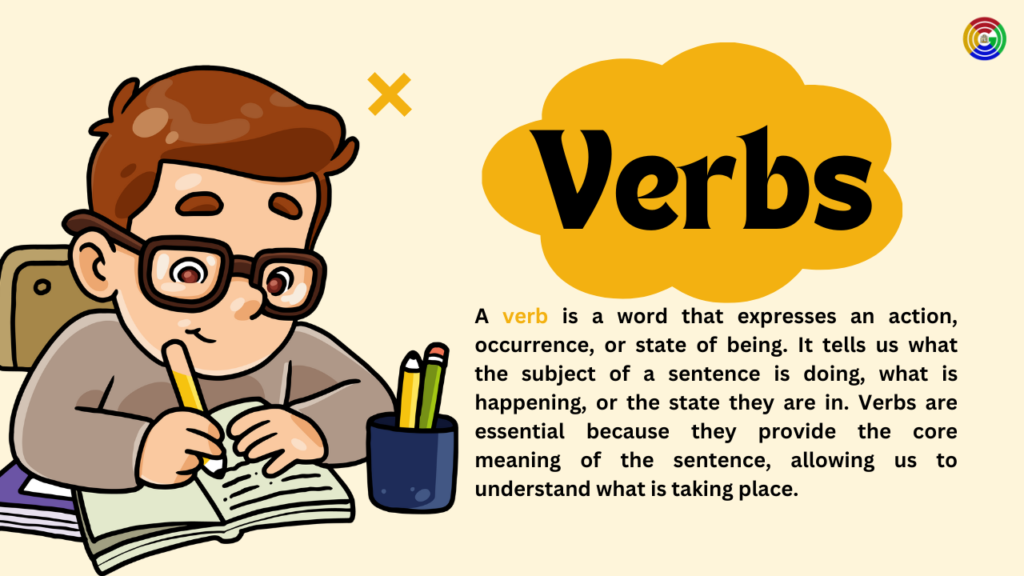Verbs : Verbs are one of the most essential components in any language, serving as the backbone of sentences and enabling us to express actions, states, and occurrences. In this blog, we’ll dive deep into verbs, exploring their definition, types, uses, and examples to give you a comprehensive understanding of this fundamental grammatical element.
1. What is a Verb?
A verb is a word that expresses an action, occurrence, or state of being. It tells us what the subject of a sentence is doing, what is happening, or the state they are in. Verbs are essential because they provide the core meaning of the sentence, allowing us to understand what is taking place.
Example:
- She plays the piano.
- They are happy.
In these examples, “plays” and “are” are verbs, describing an action and a state of being, respectively.
2. Types of Verbs
Verbs are categorized into various types, each serving a specific purpose in the sentence. Here are the primary types of verbs:
A. Action Verbs
Action verbs describe physical or mental actions that the subject performs. They help convey what someone or something is actively doing.
Examples:
- He runs every morning.
- She thinks deeply.
B. Linking Verbs
Linking verbs connect the subject with more information about the subject. Rather than showing action, they link the subject to a subject complement, such as an adjective or a noun.
Examples:
- The soup tastes delicious.
- They are doctors.
Common Linking Verbs: am, is, are, was, were, seem, look, appear, feel, become, grow, remain, sound, taste
C. Helping (Auxiliary) Verbs
Helping verbs assist the main verb to form different tenses, moods, or voices. They work alongside the main verb to provide additional context or clarity.
Examples:
- She has finished her homework.
- We will be going to the concert.
Common Helping Verbs: is, am, are, was, were, do, did, have, has, had, will, shall, should, would, can, could, may, might, must
D. Modal Verbs
Modal verbs are a type of auxiliary verb used to indicate possibility, ability, permission, or obligation. They modify the meaning of the main verb and express the speaker’s attitude.
Examples:
He can swim very well.
You must complete the assignment.
Common Modal Verbs: can, could, may, might, must, shall, should, will, would
E. Transitive Verbs
Transitive verbs require a direct object to complete their meaning. They transfer action from the subject to the object.
Examples:
She kicked the ball.
I wrote a letter.
In these sentences, “ball” and “letter” are direct objects that receive the action of the verbs “kicked” and “wrote.”
F. Intransitive Verbs
Intransitive verbs do not require a direct object to complete their meaning. The action or state they describe is complete by itself.
Examples:
- Birds fly.
- He sleeps soundly.
Here, the verbs “fly” and “sleeps” do not need a direct object; they stand alone.
G. Regular and Irregular Verbs
Regular Verbs form their past tense by adding “-ed” or “-d” to the base form.
- Example: walk → walked, play → played
Irregular Verbs have unique past tense forms and do not follow a fixed rule.
- Example: go → went, eat → ate
3. Uses of Verbs in Sentences
Verbs are used in various forms and structures to create meaningful sentences. Here are some of the primary uses:
A. Expressing Actions
The most common use of verbs is to show actions, either physical or mental.
Examples:
- She reads a book.
- He considers every possibility.
B. Describing States of Being
Verbs can also describe states, connecting the subject to descriptions of its condition or identity.
Examples:
- They are excited.
- The cake seems delicious.
C. Indicating Time and Tense
Verbs convey when an action happens, using different tenses: past, present, and future.
Examples:
- She cooks dinner every day. (Present tense)
- He cooked dinner yesterday. (Past tense)
- They will cook dinner tomorrow. (Future tense)
D. Expressing Possibility, Ability, Permission, and Obligation
Modal verbs help indicate likelihood, necessity, permission, or ability.
Examples:
- She might attend the meeting. (Possibility)
- You can start now. (Ability)
- We must leave soon. (Obligation)
4. Examples of Verbs in Action
Here are a few examples to show how verbs operate in different sentence structures:
- Action Verb: He dances gracefully.
- Linking Verb: The sky looks cloudy.
- Helping Verb: They are watching a movie.
- Modal Verb: You should try this recipe.
- Transitive Verb: She bought a new dress.
- Intransitive Verb: The child laughed.
5. Common Mistakes with Verbs
Understanding verbs includes being aware of some common mistakes:
Confusing Action and Linking Verbs: Some verbs, like “look” and “feel,” can function as either action or linking verbs depending on the sentence.
- Correct: She looks tired. (Linking)
- Incorrect: She looks tiredly. (Misuse as action verb)
Using Incorrect Verb Tenses: Verb tense errors are common, especially in complex sentences.
- Correct: By the time he arrived, I had left.
- Incorrect: By the time he arrived, I have left.
Conclusion
Verbs are an indispensable part of sentence structure, conveying actions, states, and possibilities in any language. By mastering the types, uses, and functions of verbs, you can bring clarity, precision, and energy to your writing and speech. Remember, practice makes perfect, so try using these examples and explanations to craft sentences and improve your grammatical skills!
Also is Read
| Parts of Speech | Link |
| 1. Noun | click here |
| 2. Pronoun | click here |
| 3. Adjective | click here |
| 4. Verb | click here |
| 5. Adverb | click here |
| 6. Prepositions | click here |
| 7. Conjunction | click here |
| 8. interjection | click here |




